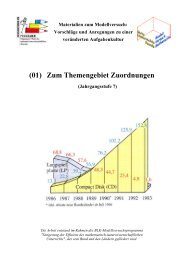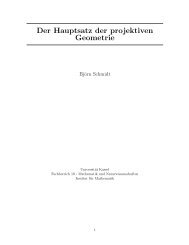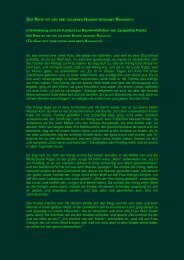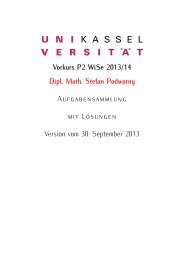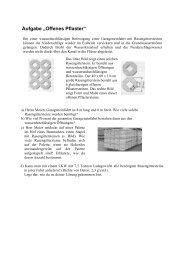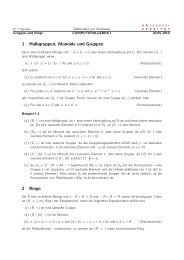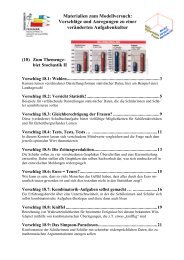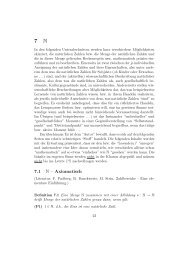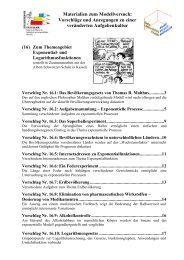Recurrence equations and their classical orthogonal polynomial ...
Recurrence equations and their classical orthogonal polynomial ...
Recurrence equations and their classical orthogonal polynomial ...
You also want an ePaper? Increase the reach of your titles
YUMPU automatically turns print PDFs into web optimized ePapers that Google loves.
318 W. Koepf, D. Schmersau / Appl. Math. Comput. 128 (2002) 303–327<br />
the falling factorials xn :¼ xðx 1Þ ðx n þ 1Þ satisfy<br />
Dx n ¼ nx n 1 :<br />
It turns out that they are connected with the Charlier <strong>polynomial</strong>s by the<br />
limiting process<br />
limð<br />
1Þ<br />
l!0 n l n c ðlÞ<br />
n<br />
ðxÞ ¼lim<br />
l!0 ðx n þ 1Þ n 1F1<br />
¼ð 1Þ n ðx n þ 1Þ n ¼ x n ;<br />
n<br />
x n þ 1 l<br />
where we used the hypergeometric representation given in [18, (2.7.9)].<br />
Note, however, that other than in the differential equation case the above<br />
type of difference equation is not invariant under general linear transformations,<br />
but only under integer shifts. We will have to take this under consideration.<br />
The <strong>classical</strong> discrete <strong>orthogonal</strong> <strong>polynomial</strong>s satisfy a recurrence equation<br />
(1)<br />
pnþ1ðxÞ ¼ðAnx þ BnÞpnðxÞ Cnpn 1ðxÞ<br />
with An; Bn <strong>and</strong> Cn given by Theorem 1.<br />
Similarly as in the continuous case, this information can be used to generate<br />
an algorithm to test whether or not a given holonomic recurrence equation has<br />
<strong>classical</strong> discrete <strong>orthogonal</strong> <strong>polynomial</strong> solutions. Obviously the first three<br />
steps of this algorithm agree with those given in Algorithm 1.<br />
Algorithm 2. This algorithm decides whether a given holonomic three-term<br />
recurrence equation has <strong>classical</strong> discrete <strong>orthogonal</strong> <strong>polynomial</strong> solutions, <strong>and</strong><br />
returns <strong>their</strong> data if applicable.<br />
1. Input: A holonomic three-term recurrence equation<br />
qnðxÞpnþ2ðxÞþrnðxÞpnþ1ðxÞþsnðxÞpnðxÞ ¼0 ðqnðxÞ; rnðxÞ; snðxÞ 2Q½n; xŠÞ:<br />
2. Shift: Shift by maxfn 2 N0 j n is zero of either qn<br />
essary.<br />
1ðxÞ or snðxÞg þ 1ifnec-<br />
3. Rewriting: Rewrite the recurrence equation in the form<br />
pnþ1ðxÞ ¼tnðxÞpnðxÞþunðxÞpn 1ðxÞ ðtnðxÞ; unðxÞ 2Qðn; xÞÞ:<br />
If either tnðxÞ is not a <strong>polynomial</strong> of degree one in x or unðxÞ is not constant<br />
with respect to x, return ‘‘no <strong>orthogonal</strong> <strong>polynomial</strong> solution<br />
exists’’; exit.<br />
4. Linear transformation: Rewrite the recurrence equation by the linear transformation<br />
x 7! ðx gÞ=f with (as yet) unknowns f <strong>and</strong> g.<br />
5. St<strong>and</strong>ardization: Given now An; Bn <strong>and</strong> Cn by<br />
pnþ1ðxÞ ¼ðAnxþ BnÞpnðxÞ<br />
define<br />
Cnpn 1ðxÞ ðAn; Bn; Cn 2 QðnÞ; An 6¼ 0Þ;





